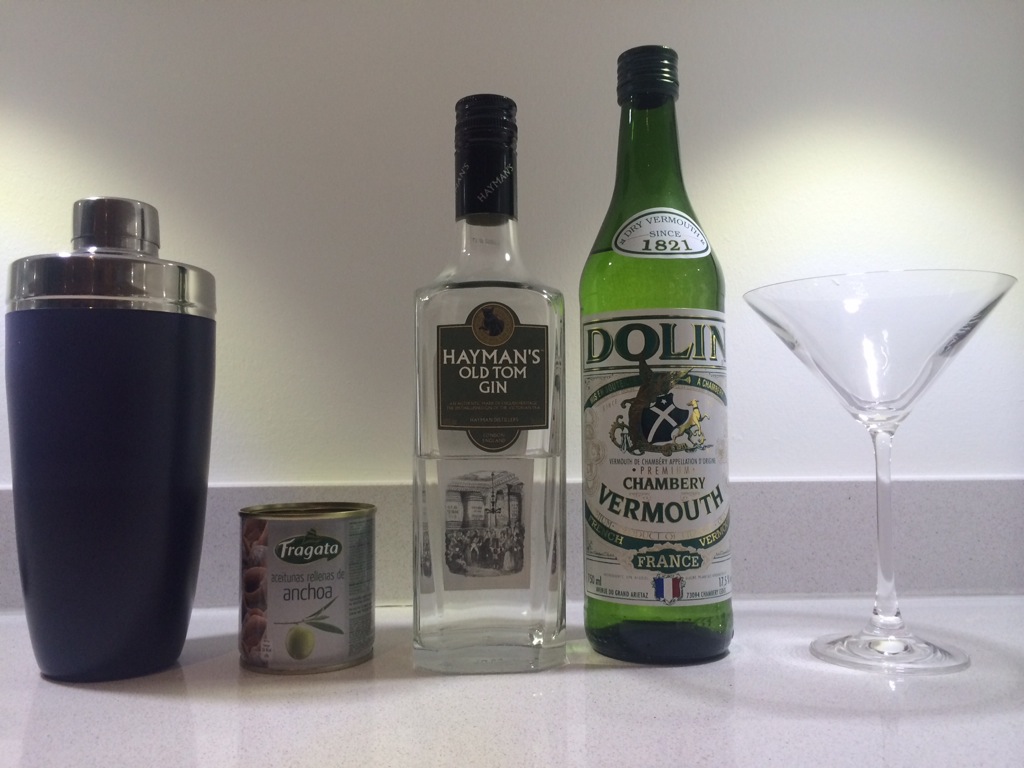My friend Joe bought his first bottle of gin today, and asked me what to do with it. The good news was that he’d made an excellent choice in Tanqueray No. 10, but it’s most certainly a martini gin and its delicate citrus flavours would be lost in a G&T. (I have seen it used in G&T on a number of ‘high end’ bars’ drinks menus and know immediately to order a pint.)
I’ve been meaning to document my own martini-making process for a long time, so here’s a quick attempt at a (soon to be longer) post.
The Basics
A martini1 is a mixture of gin, a juniper-based spirit derived from the similar Dutch spirit jenever, and vermouth, a fortified wine flavoured with a range of botanicals. It is served chilled in a conical cocktail glass.
That’s pretty much it. The martini was invented in an era when quality liquor was difficult to come by, and the ratio of gin to vermouth has steadily declined from 2:1 in the early 20th century to a more usual 7:1 today. Because it’s such a simple drink, the quality of the ingredients is incredibly important to the finished product. If you want to make a martini with Gordon’s you’re wasting your time.
 The tools and ingredients of a martini, except ice. Cocktail shaker, olives, gin, vermouth, and a cocktail glass.
The tools and ingredients of a martini, except ice. Cocktail shaker, olives, gin, vermouth, and a cocktail glass.
The Ingredients
-
Gin. The main ingredient, discussed in the following section.
-
Vermouth. Martini is best avoided. Noilly Prat is much better, with a higher wine content per litre. My favourite is Dolin Dry, which has less sugar added than Noilly.
-
Ice. Three cubes from the tray in your freezer aren’t going to get the job done. Neither is ice that’s ages old and has developed an ice beard; it’ll dilute the drink to much. Your best bet is a bag of ice from a supermarket, with pieces as large as you can find. I haven’t done sufficient research in this area to recommend any in particular, I usually use The Ice Co. from Sainsbury’s which suffice.
-
Olives. Olives should be stored in brine and they’re largely personal preference, except of course to say they should be good quality (though that doesn’t mean large). When making a 1951 martini I use Fragata Anchovy Stuffed Olives, which are absolutely sublime, but may stretch the definition too far for a standard martini. Otherwise any good quality Manzanilla olives are the way to go.
The Gin
Gin is the primary ingredient in a martini and as such the choice is an important one. Not all good gins make good martinis—the best gins for martinis are reserved, tending not to overdo the flavour of the botanicals lest it overpower the drink. Bombay Sapphire and Hendrick’s are unsuited to martinis for this reason. Tanqueray and Plymouth Original are more down-the-line gins that offer better returns. My two current favourites are The Botanist (recently discovered, possibly a fling) and Tanqueray No. 10. (a long and dedicated relationship).
Gin can be expensive and there appears to be a superfluity of artisanal gins around presently, so make sure you’re happy with the price of whatever gin you buy. At the bargain basement end of the spectrum is Aldi’s award winning Oliver Cromwell gin for less than £10, which is absolutely superb.
The Method
Noel Coward famously said the way to get the required amount of vermouth into one’s martini was to hold it in the direction of Italy. I’m not that proscriptive, but I do prefer very dry martinis. This recipe makes enough for two.
-
Fill two cocktail glasses with ice and set aside.
-
Half-fill a cocktail shaker with ice and add roughly 20 ml of vermouth—it doesn’t have to be particularly accurate.
-
Vigorously shake until the ice is coated with the vermouth, then drain off as much as the (now slightly watery) vermouth as you like. I tend to leave very little—maybe 5 ml.
-
Add 100–140 ml of gin. Stir gently with a cocktail spoon, for no more than 30 seconds. Never shake.
-
Empty the ice from the glasses and shake to get as much water out as possible (there should be very little anyway).
-
Pour the mixture from the shaker into the glasses, and garnish with two olives on a cocktail stick. One is miserly, three is an extravagance.
Martinis are deceptively simple to describe and horribly difficult to perfect. Most of what I own is currently in boxes, but once I’ve moved house (next week) I’ll update this with some photographs and my favourite variation of the standard American martini, the 1951 martini.
-
A note on language: martini is singular and uncapitalised. Its plural is martinis. There is no panini/panino confusion to be had here. ↩